This was published 5 years ago
Tuscany self-guided walk: Hot on the trail of Italian beauty
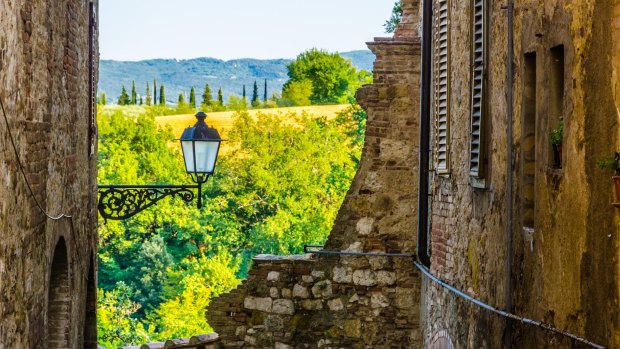
Colle val d'Elsa, Italy.Credit: Shutterstock
Imagine this – spring in Tuscany. It's an enduring fantasy, mythologised in literature and film, of a sacred place of simple enchantment where our better selves emerge.
And I find it is true – this hilltop towns of Tuscany seven-day walk is one of the loveliest in years of writing about wonderful walks. Tuscany reveals itself as a seductive place whose lifestyle, landscape and culture truly do inspire the fabled spiritual regeneration.
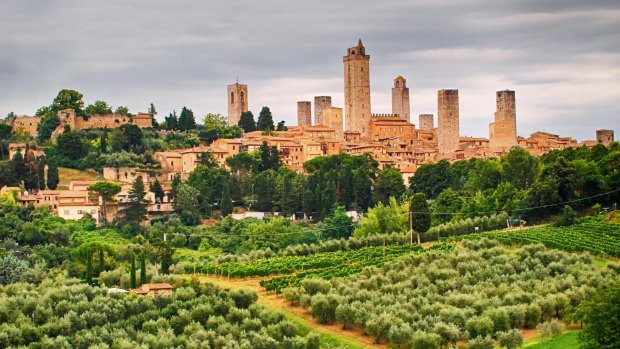
The medieval skyline of San Gimignano, Siena.Credit: Shutterstock
Of course this idealised notion of Tuscany, as a place where cares are shed as leaves from an autumn tree is a great travellers' cliche, explored in such books as E.M. Forster's Room With a View and Frances Mayes' Under the Tuscan Sun. However there's wisdom in cliches. This self-guided walk from the Etruscan town of Volterra though Chianti vineyards via medieval San Gimignano to Siena is one of Inntravel's most beloved journeys, emphasising life's simple beauty.
Some return repeatedly, seeking the harmony expressed in a bewitching landscape, which has been immortalised by artists such as the Tuscan master, Giotto, who became a model for Renaissance artists.
If it were only the landscape however, Tuscany would return to the ranks of merely the exquisite. But this area, settled about 1000 years ago by the Etruscans, then the Romans, has embraced the kind of civilisation that values history, traditional, simple seasonal fare, feasts and festivals, custom and community. In Tuscany, the patterns of life are honoured.
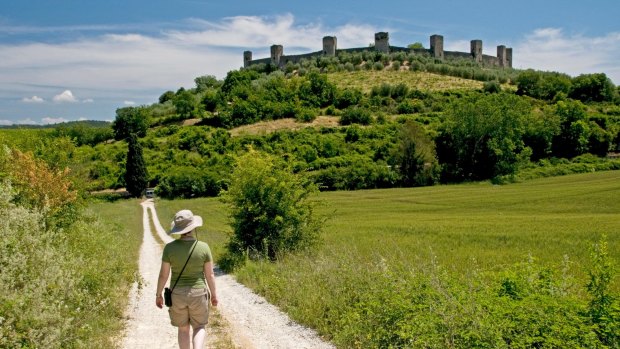
The hilltop village of MonteriggioniCredit: Alamy
Despite the tourist buses invading the larger hilltop towns, there's still integrity to these honey-coloured hamlets.
As the world modernises furiously, timeless Tuscany strengthens and the happiest way to experience this unique society is on foot. In the magic month of May, as poppies flood the fields, cherries dance on trees, roses and honeysuckle explode across hedgerows and early summer black truffles perfume every risotto, rural Tuscany lies empty of walkers.
For six days, we will walk 70 kilometres between hilltop towns. It's not over-taxing, however where there is a valley, there is always a hill.
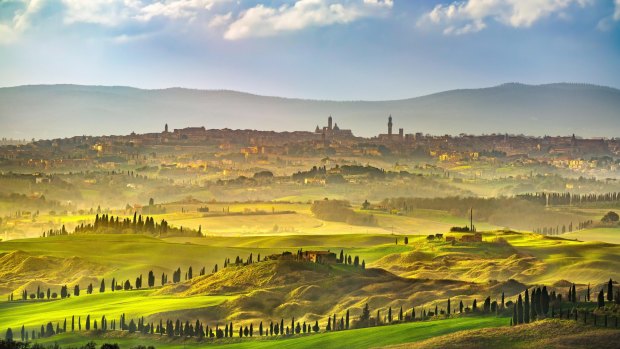
The rolling hills surrounding Siena.
Hotel San Lino in the walled, seventh-century hilltown of Volterra, close to the city walls and Roman Amphitheatre, was once home to a nuns' closed order. Our room, named for "Suor Clementina", has a geranium-bedecked balcony with views across oceans of Tuscan hills towards the Mediterranean and Corsica.
Volterra, a centuries-old alabaster trade centre, is proud of its Etruscan heritage. Narrow ancient streets lined with tower houses twist towards the central piazza. The outer wall is mostly Etruscan and the Museo Etrusco Guarnacci has a trove of artefacts, including more than 600 ancient funerary urns.
The Porta all'Arco has three mysterious heads thought to represent Etruscan divinities. In 1944, when the Germans threatened to destroy the gate, locals blocked it with stone to save it.
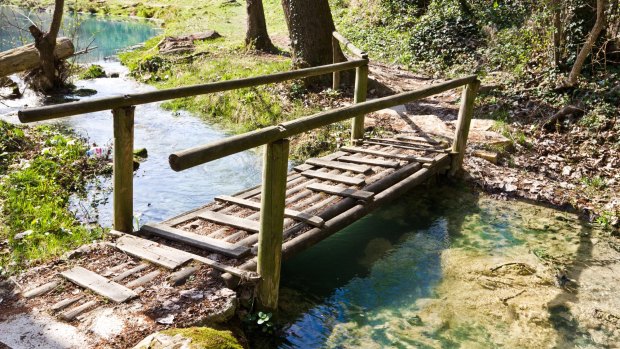
Wooden bridge on the path beside the Elsa river.Credit: Shutterstock
With its impressive towers and medieval, Roman and Etruscan stone architecture rising severely above undulating wheatfields and sandstone crags, Volterra is probably one of the more authentic, less touristy Tuscan hilltowns – dramatic with none of the classic Tuscan softness that will come later.
It was probably this very theatricality that prompted Stephenie Meyer to set scenes from her vampire saga, Twilight, here.
Our first 9.5-kilometre walk to explore the hills south of the town involves a bus trip to the valley town of Saline, then an uphill hike to Volterra, at 600 metres. We walk the old rack-railway that once ran from Saline to Volterra, the temperature nudges 30 degrees and Volterra's jutting profile remains maddeningly distant.
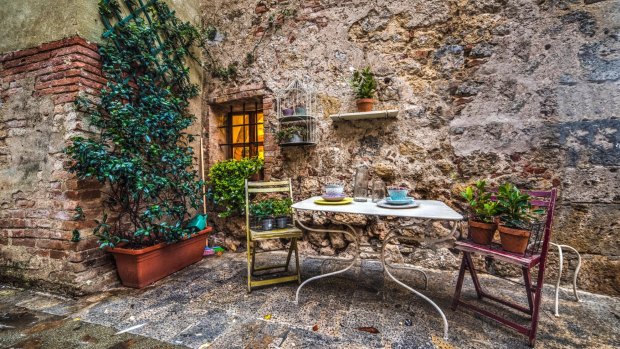
A quaint corner of Monteriggioni.Credit: Shutterstock
This initial climb blows both cobwebs and jetlag, but reminds us that adequate water, sunscreen, walking poles and protective clothing are important. The hotel restaurant, Il Papi, introduces us to Volterra's rustic fare of tagliere di salumi toscani, zuppa alla Volterrana, wild boar pappardelle, porcini and truffles.
A more classic Tuscan countryside unfolds the next day on our 13-kilometre walk to San Gimignano – Manhattan of the Middle Ages – with its 14th-century towers, on the 1900-kilometre Via Francigena, the medieval pilgrim route from Canterbury to Rome.
We enter a rich landscape of scented sweet chestnut and holm oak woods, silver olive groves, neat vineyards wedged by wheatfields and on hills, Renaissance villas, honey-coloured castles, Romanesque pievi or rural churches, isolated poderi and agriturismi (farmsteads), all fringed by ranks of the sacred cypress. Above is the rose-gold sky. No wonder the masters painted compulsively.
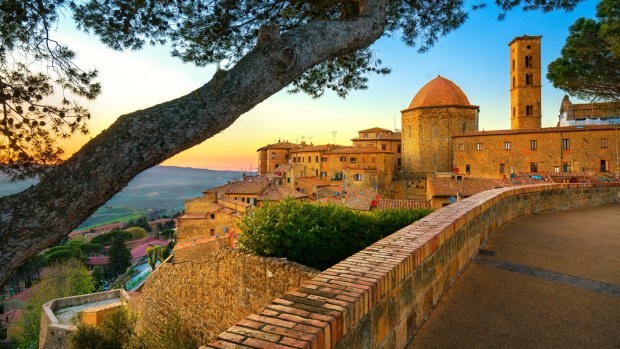
Volterra at sunset.Credit: Shutterstock
To walk in Tuscany is to employ all senses – the spectacle of Mediterranean macchia tumbling across hills and gullies – fragrant yellow broom, thyme, rosemary, citrus, oleander, meadow flowers within a green palette – sage for the olives and lavender, chartreuse for the wheat, lime for the vines, emerald for the oaks, moss for the woodland.
The sensation of early morning spider silk brushing bare arms, the delicate chirruping of tiny woodland birds, swallows and swifts wheeling, the contrast of dry heat and forest cool, the chunky suck of clay on boots and rustle of wheatfields. The woodland tracks and white strade bianche that ramble between summits, with charm but little functional directness.
Newly sprouting figs and olives, proud purple artichokes, fruit-laced cherry trees and gargantuan vivid roses mark the way and there's the pervasive scent of cut grass.
We anticipate the flavours of rustic bread stuffed with prosciutto, olives capers, pecorino toscano, olive oil and pomodori secchi, eaten among begonias, viburnum and poppies in the contemplative hot post-midday siesta silence.
This is where everything produced is consumed – the glut of tomatoes, olives, truffles, mushrooms, grapes, the entire pig – all bottled, potted, dried, smoked, rendered, distilled, as it always has been.
Yes, it's hotter, wetter and more humid for late May – this time last year the country was parched – but the upside is a verdant landscape, bringing early porcini. We taste these extraordinary fungi at our family-run San Gimignano hotel, Hotel Bel Soggiorno, inside the historic walls.
Like our room with its shared verandah, the restaurant has sweeping views across a characteristic landscape. We surrender to the gentle sommelier who suggests a ruby-red, full-bodied Podere La Cappella "Querciolo" Chianti Classico 2014 from a local winery near a town we've just walked through – San Donato.
This is a 90 per cent sangiovese plus merlot blend that tastes like Tuscany – spice, orange, blackberry and cherry – perfect with our fragrant porcini, pecorino, fine herbs and truffle risotto and roasted suckling pig. San Gimignano is a peach-and-terracotta gem, but the daytime coach tourists seeking fluffy wild boar toys, Tuscan ceramics and Aperol spritzes are a trial. Be patient and by about 4pm, they are gone, leaving a peaceful night town.
Only 14 of its 70 towers remain. Chopped down to size by the Florentines, they were (still are) a reference point for Via Francigena pilgrims. We encounter a band of about 30 of them (dressed alike, one whistling) as we set off early for our 13-kilometre walk to Colle Val d'Elsa.
How will we shake this jolly peloton? Silence descends when they take a different route, fortunately, as today's walking is increasingly dazzling – streams, forests threaded by truffle hunting and divierto di caccia (no hunting) signs, cultivated fields of spring onions, garlic, potatoes and wheat, valleys and hilltops, castles, watermills and vineyards, all defined by the sculptural cypresses.
About four kilometres from the walled town of Colle, as we navigate an exposed ridge, a thunderstorm rolls in. It's quick march, entering via the upper town of Colle alto, to eat our lunch sheltering beneath European limes, before heading to Colle basso, across the River Elsa to Relais della Rovere, a former 11th-century abbey.
The hotel, named after Cardinal Giuliano della Rovere, who later became Pope Julius II and Michelangelo's patron, offers a comfortable sojourn in preparation for our final and longest day's walking – 18.5 kilometres to Siena.
Today involves a transfer to Monteriggioni, a Sienese outpost built in 1203 to defend against Florentine attacks. Dante modelled his abyss on the village in his Inferno. Appropriately, a European viper slithers across my path in a medieval flourish.
Route information is exceptional, with detailed notes, maps, places of interest, restaurants, history, local knowledge, lunch and wine-tasting suggestions. We lose ourselves occasionally but on this Via Francigena, all roads do in fact lead to Rome.
A long final climb brings us to our Siena hotel, Hotel Garden, the former summer home of an aristocrat and about 20 minutes walk to the Siena city walls at Porta Camollia. Inntravel's Siena city walk introduces us to this gorgeous city with the Campo at its heart. It's full of masterpieces, both architectural and artistic, particularly the ornate cathedral with its striped campanile and works by Donatello, Ghiberti and Jacopo della Quercia.
Lady Caroline in Elizabeth von Arnim's classic novel, The Enchanted April, had to get away to Italy "or be deafened" for her life was "a noise about nothing".
She found as we do, that Tuscany offers silence and spiritual renewal. As the world modernises furiously, timeless Tuscany remains constant, particularly fortifying all those who walk its paths.
TRIP NOTES
MORE
FLY
Emirates fly daily from Sydney and Melbourne to Venice. See emirates.com Trenitalia trains run frequently to Florence for an Inntravel taxi transfer to Volterra. See trenitalia.com
WALK
Inntravel's Hilltop Towns of Tuscany self-guided seven-day walk includes accommodation, two dinners and seven breakfasts, route notes, maps, information, luggage and route transfers. From £795 ($1420) per person sharing. See inntravel.co.uk
Alison Stewart was a guest of Inntravel
Sign up for the Traveller Deals newsletter
Get exclusive travel deals delivered straight to your inbox. Sign up now.